Kit History
Ferranti Thistle
1943
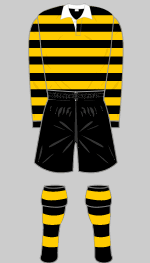
1943-1953 a c e
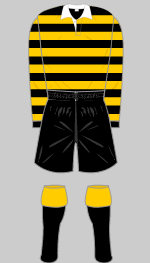
1953-1957 e

1957-1959 e
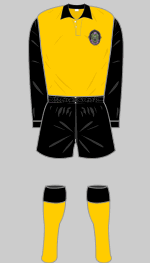
1959-1960 e
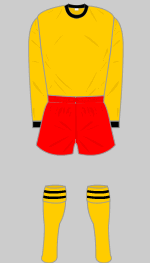
January 1960 h
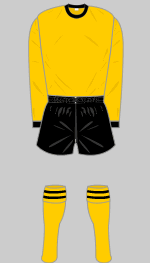
April'60-Aug'65 h
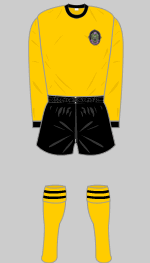
January 1968 c
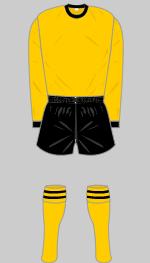
1971-1972 e

1973-1974 e
Meadowbank Thistle
1974
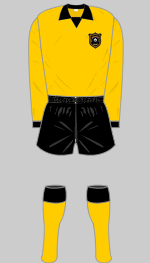
1974-1975 c

1975-1977 c
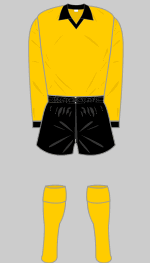
early 1977-1978 e
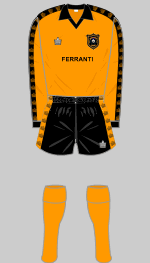
late 1977-1981 c e g
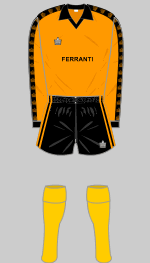
1981-1982 e
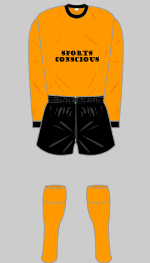
1982-1983 k

1983-1984 b c k
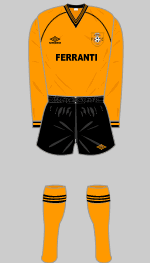
1984-1985 c
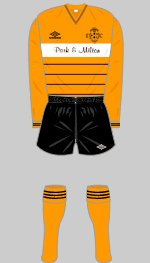
1985-1986 e m

1986-1988 c e k

1988-1990 c e k m n
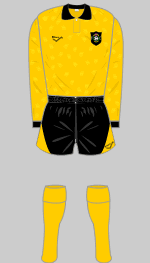
1990-1991 m
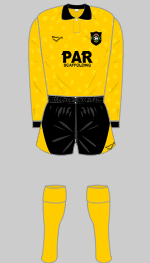
1991-1992 m
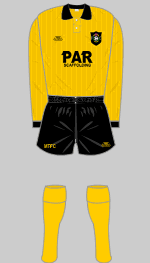
1992-1993 f k m

1993-1995 c k m
Livingston
1995

1995-1996 c

1996-1997 c
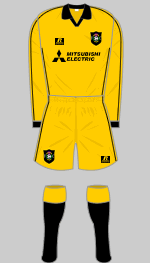
1997-1998 c
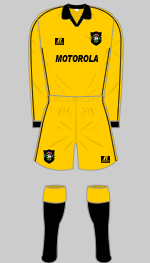
1998-1999 c

1999-2000 c
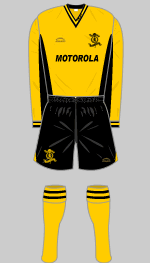
2000-2001 c

2001-2002 c d
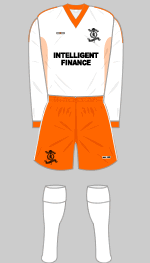
2002-2003 c d n
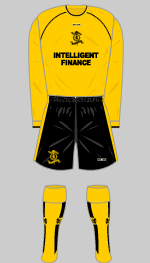
2003-2004 c d n
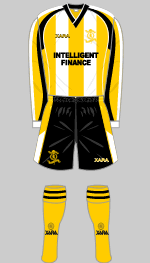
2004-2005 c d n
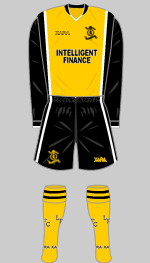
2005-2006 c d n

2006-2007 c d

2007-2008 c
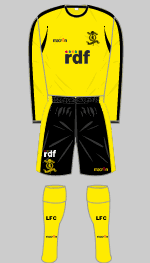
2008-2009 c
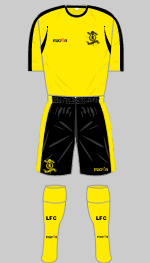
Aug-Sept 2009 i
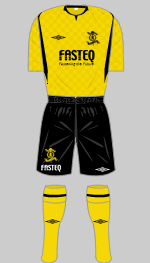
Sept 2009-2010 j c
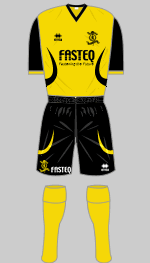
2010-2011 l
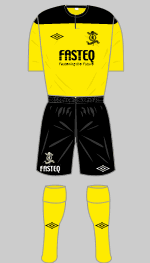
2011-2012 j
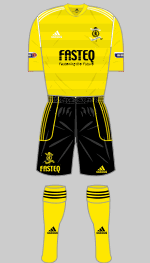
2012-2013 j

2013-2014 j
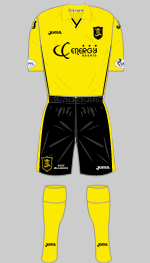
2014-2015 j n
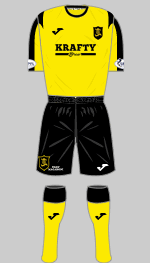
2015-2016 j
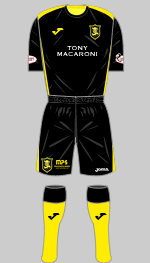
2016-2017 j
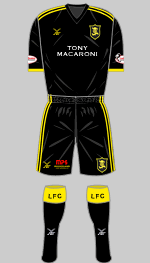
2017-2018 j
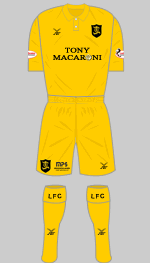
2018-2019 j

2019-2020 j
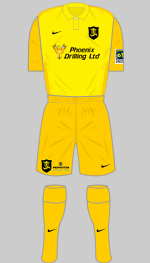
2020-2021 j
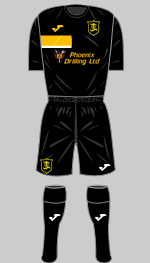
2021-2022 j
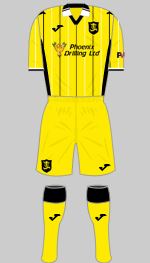
2022-2023 j
Background
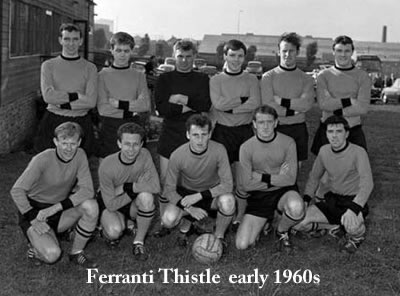 The club was originally known as Ferranti Thistle,
the works team of the giant Edinburgh based electronics firm,
Ferranti.
The club was originally known as Ferranti Thistle,
the works team of the giant Edinburgh based electronics firm,
Ferranti. 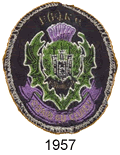
They competed in the Eastern League until they were elected to the Scottish League to even up the numbers prior to the restructuring of the league and introduction of the Premier Division in 1974. (The Second Division had consisted of 19 clubs since the demise of Third Lanark, a situation that meant one club was without a game every weekend.) The little club's elevation caused a storm of protest in the north of Scotland where a number of famous Highland League teams believed they had a better claim than this upstart works team and it was clear that Thistle had been favoured because the teams from central Scotland did not relish the prospect of trips to the far north. The controversy deepened when it became apparent that Ferranti Thistle's City Park ground (once the home of Edinburgh City) did not meet the required standard and, furthermore, objections were made about a top level senior side carrying the name of a commercial company. The problem was solved by hiring the Commonwealth Stadium from Edinburgh City Council for home games and changing the club's name to Meadowbank Thistle. While their new home met modern safety requirements, being an all-purpose stadium, it lacked the atmosphere of a purpose built ground and as tenants, Thistle often had to rearrange their home matches to avoid clashing with other scheduled events. One one occasion, they were forced to postpone a game because a dog show was being held in the rooms below the main stand!
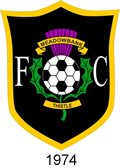 In their early days, Meadowbank were the whipping boys, finishing at
or near the bottom of the Second Division (then the third and lowest tier) on a
regular basis but by the early 1980s their performances improved and
in 1983 Meadowbank were promoted to the First Division (second tier).
Two seasons later they were back in the lowest division but in 1987
they won promotion for the second time, this time as Division Two champions,
the club's first senior honour. Alas in 1993 they were relegated once
more but the following season they finished sufficiently high in the
table to retain their place in the Scottish Second Division when another
restructuring created a fourth level. In 1995, however, the inevitable
happened and Meadowbank were relegated to the Scottish Third Division.
In their early days, Meadowbank were the whipping boys, finishing at
or near the bottom of the Second Division (then the third and lowest tier) on a
regular basis but by the early 1980s their performances improved and
in 1983 Meadowbank were promoted to the First Division (second tier).
Two seasons later they were back in the lowest division but in 1987
they won promotion for the second time, this time as Division Two champions,
the club's first senior honour. Alas in 1993 they were relegated once
more but the following season they finished sufficiently high in the
table to retain their place in the Scottish Second Division when another
restructuring created a fourth level. In 1995, however, the inevitable
happened and Meadowbank were relegated to the Scottish Third Division.
It was clear to everyone that Meadowbank had no future trying to compete
with the likes of Hearts and Hibs playing in a stadium built for athletics.
The club was then bought by Bill Hunter, who took the bold decision
to relocate to the new town of Livingston in West Lothian. In the process
the club was completely reinvented 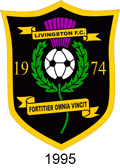 with a smart all-black kit to go
with their new name and Almondvale stadium, built by Hunter's construction
company. The club crest was updated but retained the basic design of the old Meadowbank Thistle version until 1999.
with a smart all-black kit to go
with their new name and Almondvale stadium, built by Hunter's construction
company. The club crest was updated but retained the basic design of the old Meadowbank Thistle version until 1999.
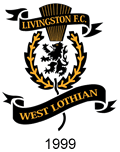 The transformation was little short of miraculous: within five years
Livingston had risen through the divisions to reach the Scottish Premier
League and in 2001 they finished in third place, earning themselves
a place in the UEFA Cup. Success came at a price, however, and in 2004
the club went into financial administration. Only weeks later, in March
2004, "Livi" met Hibernian at Hampden Park in the CIS Cup
Final (formerly the Scottish League Cup), triumphing 2-0 to win their
first major trophy. In May 2005 the club emerged from administration
under the control of the Lionhearts Consortium, who had stepped in the
previous summer to ensure the club's survival, albeit at the expenses
of relegation to the Scottish First Division (tier two).
The transformation was little short of miraculous: within five years
Livingston had risen through the divisions to reach the Scottish Premier
League and in 2001 they finished in third place, earning themselves
a place in the UEFA Cup. Success came at a price, however, and in 2004
the club went into financial administration. Only weeks later, in March
2004, "Livi" met Hibernian at Hampden Park in the CIS Cup
Final (formerly the Scottish League Cup), triumphing 2-0 to win their
first major trophy. In May 2005 the club emerged from administration
under the control of the Lionhearts Consortium, who had stepped in the
previous summer to ensure the club's survival, albeit at the expenses
of relegation to the Scottish First Division (tier two).
At the end of the 2008-09 season, rumours of another serious financial crisis spread, despite the repeated denials of the club's owner, Italian lawyer Angelo Massone. It emerged that Livingston owed West Lothian Council £330,000 in unpaid rent for Almondvale Stadium. It also emerged that the club's electricity has been cut off because of unpaid bills, the players' wages had been persistently late and a large sum was owed to the Revenue in unpaid taxes. The council offered to waive some of this provided that Massone came up with evidence that the club could meet its outstanding obligations by 30 June. After failing to receive a satisfactory response, West Lothian Council took the matter to court and three weeks later Livi went into administration. On 28 July the administrators' interim manager, Donald MacGruther, issued redundancy notices, the first step in liquidating the club. On the following day, however, the SFL agreed to relax its own rules and allow a new company called Livingston 5 Ltd, formed by former Dumbarton chairman Neil Rankine and ex-Cowdenbeath owner Gordon McDougall, who had previously made separate attempts to take over the club from Massone, who agreed to sell his shares in the club two days later. In a dramatic twist, the SFL then announced that Livi would be demoted to the Third Division, despite having previously appeared to give public assurances that the team would continue in Division One. Livingston's new owners refused to play their opening fixture with East Stirlingshire pending their appeal, risking further sanction. After their appeals were turned down by the SFL and SFA the club's management accepted their fate and 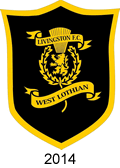 concentrated on the league.
concentrated on the league.
Livi ended the 2009-10 season as Third Division champions and then ran away with the Second Division title to wind up back where they believed they should have been two seasons previously.
In 2014 the crest was updated with the restoration of a traditionally shaped shield.
Livvi finished second in 2017-18 and entered the promotion play-offs where they beat Partick Thistle for a place in the Premiership for the first time since 2006.
With grateful thanks to Alex Horsburgh.
Sources
- (a) The Ferranti Collection
- (b) Brechin City Official Site
- (c) Livi Lions An interesting unofficial site that includes a fine graphic collection of previous kits by Alasdair MacNeill
- (d) SNS Pix
- (e) Alick Milne
- (f) Raith Rovers FC 1991/92 - 1995/96 Images of Sport (Tony Finister 2002)
- (g) Meadowbank Thistle FC (2007)
- (h) John Small
- (i) Picasaweb
- (j) Livingston official website
- (k) Donald Gellatly
- (l) Livingston FC Official Website (Kit History by Alasdair MacNeill)
- (m) Jim McQueen
- (n) Ian McConnel
Photograph courtesy of Granton History Group. Crest history provided by Alasdair MacNèill. Crests are the property of Livingston FC.


